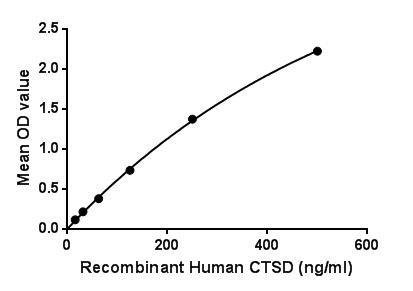组织蛋白酶D(CTSD)活性蛋白
Active Cathepsin D (CTSD)
CPSD; CLN10; Lysosomal Aspartyl Protease; Ceroid-Lipofuscinosis,Neuronal 10
- 编号APB280Hu61
- 物种Homo sapiens (Human,人) 相同的名称,不同的物种。
- 缓冲液成份磷酸盐缓冲液(pH7.4,含有 0.01% SKL, 1mM DTT, 5% Trehalose和Proclin300.)
- 性状冻干粉
- 纯度> 97%
- 等电点6.1
- 应用Cell culture; Activity Assays.
- 下载 英文说明书 中文说明书
- 规格 10µg50µg 200µg 1mg 5mg
- 价格 ¥ 2016 ¥ 5040 ¥ 10080 ¥ 30240 ¥ 75600
- 欲了解实际交易价格和更多情况,请与当地经销商联系!
活性实验

Figure. The binding activity of CTSD with HSP90b1.
Cathepsin D (CSTD) is an aspartic protease that depends critically on protonation of its active site Asp residue. Along with Asp-protonation, lower pH also leads to conformational switch in cathepsin-D: the N-terminal segment of the protease moves out of the active site as pH drops. Similar to other aspartic protainases, cathepsin D accommodates up to 8 amino acid residues in the binding cleft of the active site. The main physiological functions of cathepsin D consist of metabolic degradation of intracellular proteins, activation and degradation of polypeptide hormones and growth factors, activation of enzymatic precursors, processing of enzyme activators and inhibitors, brain antigen processing and regulation of programmed cell death. Besides, Heat Shock Protein 90kDa Beta 1 (HSP90b1) has been identified as an interactor of CSTD, thus a binding ELISA assay was conducted to detect the interaction of recombinant human CSTD and recombinant human HSP90b1. Briefly, CSTD were diluted serially in PBS, with 0.01% BSA (pH 7.4). Duplicate samples of 100μL were then transferred to HSP90b1-coated microtiter wells and incubated for 2h at 37℃. Wells were washed with PBST and incubated for 1h with anti-CSTD pAb, then aspirated and washed 3 times. After incubation with HRP labelled secondary antibody, wells were aspirated and washed 3 times. With the addition of substrate solution, wells were incubated 15-25 minutes at 37℃. Finally, add 50µL stop solution to the wells and read at 450nm immediately. The binding activity of CSTD and HSP90b1 was shown in Figure 1, and this effect was in a dose dependent manner.
用法
Reconstitute in 20mM Tris, 150mM NaCl (PH8.0) to a concentration of 0.1-1.0 mg/mL. Do not vortex.
储存
避免反复冻融。2-8°C不超过一个月,-80°C不超过12个月。
稳定性
热稳定性以损失率显示。损失率是由加速降解试验决定,具体方法如下:在37°C孵育48小时,没有显著的降解或者沉淀产生。保质期内,在适当的条件下存储,损失率低于5%。
增值服务
相关产品
| 编号 | 适用物种:Homo sapiens (Human,人) | 应用(仅供研究使用,不用于临床诊断!) |
| APB280Hu61 | 组织蛋白酶D(CTSD)活性蛋白 | Cell culture; Activity Assays. |
| EPB280Hu61 | 组织蛋白酶D(CTSD)真核蛋白 | Positive Control; Immunogen; SDS-PAGE; WB. |
| RPB280Hu01 | 组织蛋白酶D(CTSD)重组蛋白 | Positive Control; Immunogen; SDS-PAGE; WB. |
| APB280Hu62 | 组织蛋白酶D(CTSD)活性蛋白 | Cell culture; Activity Assays. |
| EPB280Hu62 | 组织蛋白酶D(CTSD)真核蛋白 | Positive Control; Immunogen; SDS-PAGE; WB. |
| RPB280Hu02 | 组织蛋白酶D(CTSD)重组蛋白 | Positive Control; Immunogen; SDS-PAGE; WB. |
| RPB280Hu03 | 组织蛋白酶D(CTSD)重组蛋白 | Positive Control; Immunogen; SDS-PAGE; WB. |
| RPB280Hu04 | 组织蛋白酶D(CTSD)重组蛋白 | Positive Control; Immunogen; SDS-PAGE; WB. |
| PAB280Hu02 | 组织蛋白酶D(CTSD)多克隆抗体 | WB; IHC; ICC; IP. |
| PAB280Hu01 | 组织蛋白酶D(CTSD)多克隆抗体 | WB; IHC; ICC; IP. |
| LAB280Hu71 | 组织蛋白酶D(CTSD)多克隆抗体(生物素标记) | WB; IHC; ICC. |
| MAB280Hu21 | 组织蛋白酶D(CTSD)单克隆抗体 | WB; IHC; ICC; IP. |
| MAB280Hu26 | 组织蛋白酶D(CTSD)单克隆抗体 | WB; IHC; ICC; IP. |
| MAB280Hu22 | 组织蛋白酶D(CTSD)单克隆抗体 | WB; IHC; ICC; IP. |
| FAB280Hu02 | 抗组织蛋白酶D(CTSD)单克隆抗体 | Flow cytometry. |
| SEB280Hu | 组织蛋白酶D(CTSD)检测试剂盒(酶联免疫吸附试验法) | Enzyme-linked immunosorbent assay for Antigen Detection. |
| HEB280Hu | 组织蛋白酶D(CTSD)检测试剂盒(酶联免疫吸附试验法,高敏型) | Enzyme-linked immunosorbent assay for Antigen Detection. |
| LMB280Hu | 组织蛋白酶D(CTSD)等多因子检测试剂盒(流式荧光发光法) | FLIA Kit for Antigen Detection. |
参考文献
| 杂志 | 参考文献 |
| Molecular Immunology | Cathepsin D is released after severe tissue trauma in vivo and is capable of generating C5a in vitro [ScienceDirect: S0161589011008297] |
| 21 | Plasma Cathepsin D Levels: A Novel Tool to Predict Pediatric Hepatic Inflammation [PubMed: 25732418] |
| Scientific Reportes | Plasma cathepsin D correlates with histological classifications of fatty liver disease in adults and responds to intervention [pubmed:27922112] |
| Biomedicine & pharmacotherapy | Berberine ameliorates intrahippocampal kainate-induced status epilepticus and consequent epileptogenic process in the rat: Underlying mechanisms [pubmed:28061403] |
| JGH OPEN | Limited applicability of cathepsin D for the diagnosis and monitoring of non‐alcoholic steatohepatitis [] |
| Diabetologia | Plasma cathepsin D activity is negatively associated with hepatic insulin sensitivity in overweight and obese humans [Pubmed: 31690989] |
| Antioxidants | Iron and Advanced Glycation End Products: Emerging Role of Iron in Androgen Deficiency in Obesity [Pubmed: 32235809] |
| Peptides | LVV-hemorphin-7 (LVV-H7) plays a role in antinociception in a rat model of alcohol-induced pain disorders [33253777] |
| Cells | Identification of Cathepsin D as a Plasma Biomarker for Alzheimer's Disease [33445607] |
| J Chem Neuroanat | Analysis of silymarin-modulating effects against acrylamide-induced cerebellar damage in male rats: Biochemical and pathological markers [33965515] |
| Front Cell Infect Microbiol | PGRS Domain of Rv0297 of Mycobacterium tuberculosis Is Involved in Modulation of Macrophage Functions to Favor Bacterial Persistence [33042856] |
| Nutr Metab Cardiovasc Dis | Serum CathepsinD in pregnancy: relation with metabolic and inflammatory markers and effects of fish oils and probiotics [Pubmed:35304048] |
| Biosensors | A Comparison of Various Chips Used for the Manufacture of Biosensors Applied in Non-Fluidic Array SPRi, Based on the Example of Determination of Cathepsin D [Pubmed:35049649] |

